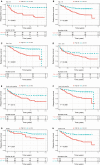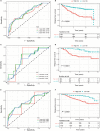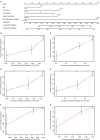An estrogen receptor (ER)-related signature in predicting prognosis of ER-positive breast cancer following endocrine treatment
- PMID: 31124293
- PMCID: PMC6652714
- DOI: 10.1111/jcmm.14338
An estrogen receptor (ER)-related signature in predicting prognosis of ER-positive breast cancer following endocrine treatment
Abstract
Quite a few estrogen receptor (ER)-positive breast cancer patients receiving endocrine therapy are at risk of disease recurrence and death. ER-related genes are involved in the progression and chemoresistance of breast cancer. In this study, we identified an ER-related gene signature that can predict the prognosis of ER-positive breast cancer patient receiving endocrine therapy. We collected RNA expression profiling from Gene Expression Omnibus database. An ER-related signature was developed to separate patients into high-risk and low-risk groups. Patients in the low-risk group had significantly better survival than those in the high-risk group. ROC analysis indicated that this signature exhibited good diagnostic efficiency for the 1-, 3- and 5-year disease-relapse events. Moreover, multivariate Cox regression analysis demonstrated that the ER-related signature was an independent risk factor when adjusting for several clinical signatures. The prognostic value of this signature was validated in the validation sets. In addition, a nomogram was built and the calibration plots analysis indicated the good performance of this nomogram. In conclusion, combining with ER status, our results demonstrated that the ER-related prognostic signature is a promising method for predicting the prognosis of ER-positive breast cancer patients receiving endocrine therapy.
Keywords: breast cancer; estrogen receptor; nomogram; prognosis.
© 2019 The Authors. Journal of Cellular and Molecular Medicine published by John Wiley & Sons Ltd and Foundation for Cellular and Molecular Medicine.
Conflict of interest statement
The authors declare that they have no conflict of interest.
Figures






Similar articles
-
A prognostic eight-lncRNA expression signature in predicting recurrence of ER-positive breast cancer receiving endocrine therapy.J Cell Physiol. 2020 May;235(5):4746-4755. doi: 10.1002/jcp.29352. Epub 2019 Oct 29. J Cell Physiol. 2020. PMID: 31663114
-
A Potential Prognostic Long Noncoding RNA Signature to Predict Recurrence among ER-positive Breast Cancer Patients Treated with Tamoxifen.Sci Rep. 2018 Feb 16;8(1):3179. doi: 10.1038/s41598-018-21581-w. Sci Rep. 2018. PMID: 29453409 Free PMC article.
-
Identification of a prognostic LncRNA signature for ER-positive, ER-negative and triple-negative breast cancers.Breast Cancer Res Treat. 2020 Aug;183(1):95-105. doi: 10.1007/s10549-020-05770-8. Epub 2020 Jun 29. Breast Cancer Res Treat. 2020. PMID: 32601968
-
[Gene expression classifiers in the prognosis of breast cancer].Ned Tijdschr Geneeskd. 2014;158:A7001. Ned Tijdschr Geneeskd. 2014. PMID: 24780571 Review. Dutch.
-
High-risk estrogen-receptor-positive breast cancer: identification and implications for therapy.Mol Diagn Ther. 2012 Aug 1;16(4):235-40. doi: 10.1007/BF03262212. Mol Diagn Ther. 2012. PMID: 22812573 Review.
Cited by
-
Weighted gene correlation network analysis identifies microenvironment-related genes signature as prognostic candidate for Grade II/III glioma.Aging (Albany NY). 2020 Nov 7;12(21):22122-22138. doi: 10.18632/aging.104075. Epub 2020 Nov 7. Aging (Albany NY). 2020. PMID: 33186124 Free PMC article.
-
A nomogram combining long non-coding RNA expression profiles and clinical factors predicts survival in patients with bladder cancer.Aging (Albany NY). 2020 Feb 12;12(3):2857-2879. doi: 10.18632/aging.102782. Epub 2020 Feb 12. Aging (Albany NY). 2020. PMID: 32047140 Free PMC article.
-
Conducive target range of breast cancer: Hypoxic tumor microenvironment.Front Oncol. 2022 Sep 26;12:978276. doi: 10.3389/fonc.2022.978276. eCollection 2022. Front Oncol. 2022. PMID: 36226050 Free PMC article. Review.
-
A nomogram based on cuproptosis-related genes predicts 7-year relapse-free survival in patients with estrogen receptor-positive early breast cancer.Front Oncol. 2023 May 12;13:1111480. doi: 10.3389/fonc.2023.1111480. eCollection 2023. Front Oncol. 2023. PMID: 37251943 Free PMC article.
-
Clinical and Multiomic Features Differentiate Young Black and White Breast Cancer Cohorts Derived by Machine Learning Approaches.Clin Breast Cancer. 2025 Apr;25(3):e301-e311. doi: 10.1016/j.clbc.2024.11.015. Epub 2024 Nov 28. Clin Breast Cancer. 2025. PMID: 39706709
References
-
- Bray F, Ferlay J, Soerjomataram I, Siegel RL, Torre LA, Jemal A. Global cancer statistics 2018: GLOBOCAN estimates of incidence and mortality worldwide for 36 cancers in 185 countries. CA Cancer J Clin. 2018;68:394‐424. - PubMed
-
- Perou CM, Sorlie T, Eisen MB, et al. Molecular portraits of human breast tumours. Nature. 2000;406:747‐752. - PubMed
Publication types
MeSH terms
Substances
LinkOut - more resources
Full Text Sources
Medical

